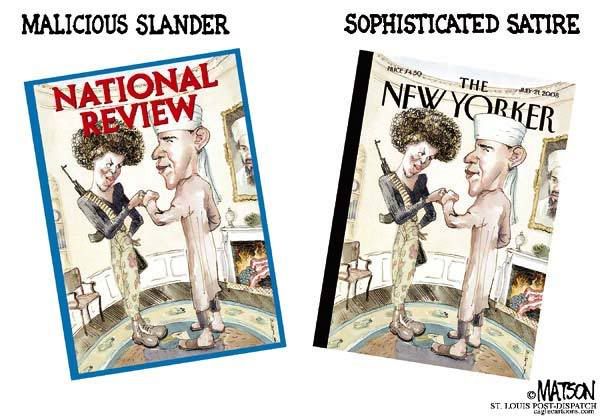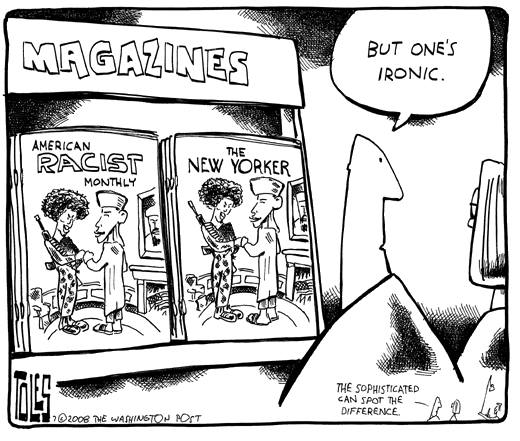The Daily Cartoonist linked to a July 17 L.A. Times story that broke the news of News & Observer cartoonist Dwayne Powell’s demotion and subsequent resignation as part of a greater piece on how editorial cartoonists are a dying breed.
The story is nothing new — I’ve written before about how rarely a month passes without another article fretting about the demise of editorial cartooning. Usually I make some snide comment about how these people are interchangeable / are proving their own irrelevance / typical “they have the good jobs and I don’t” professional jealousy masked as criticism.
But I just had to point out this juxtaposition in the L.A. Times article, which I really doubt was a subtle dig at those who occupy The Big Seats. Commentator James Rainey closes the column by saying he’s worried the loss of cartoonists will continue to “dumb-down an audience that doesn’t need any help sinking into complacency.”
Yet immediately before that kicker, Rainey offers this quote:
“McCain’s reputed explosive temper is a tantalizing prospect,” said Steve Kelley of the New Orleans Times-Picayune, “as is Obama’s abiding belief that there is no problem so simple that government can’t find a way to waste enormous resources failing to fix it.”
On the visual side, Kelley sees something of a replay of the 1996 election between President Clinton and Sen. Bob Dole. In shorthand: “Mr. Charisma against the guy who yells at kids to stay off his lawn.”
Way to dig for that insight and nuance that only cartoonists can provide, Steve.
 I’ve also been meaning to bring up the cartoonist response to the recent New Yorker Obama cover controversy, particularly as it relates to these two virtually identical cartoons from R.J. Matson and the usually brilliant Tom Toles.
I’ve also been meaning to bring up the cartoonist response to the recent New Yorker Obama cover controversy, particularly as it relates to these two virtually identical cartoons from R.J. Matson and the usually brilliant Tom Toles.
At first glance, I guess I could see how someone might think these cartoons are making a powerful, profound statement. But anyone with even a loose grip on the concept of satire is probably going to quickly figure out that the difference in context is what makes satire satire, and therefore these cartoons are almost embarrassing as an attempt at a point.
 Put Archie Bunker’s lines in the mouth of a real human on the street and they’re racist; put them in Archie Bunker’s mouth and they’re commentary. That’s how satire works.
Put Archie Bunker’s lines in the mouth of a real human on the street and they’re racist; put them in Archie Bunker’s mouth and they’re commentary. That’s how satire works.
So these cartoons are literally correct, and there’s nothing more insightful here than drawing a dog labeled “dog” and a cat labeled “cat” (not that there aren’t cartoonists who would do that) and then leaving it at that.
And for all the accusations of the New Yorker‘s elitist sense of humor — criticism of which is undeniably part of the “point” of these cartoons — does the elitism of those who dare employ satire even approach the condescension of their critics, whose argument seems to be that the New Yorker failed to take the red-state simpletons into consideration?
So getting back to Rainey’s column, we now have cartoonists apparently oblivious to the defining qualities of satire who are essentially rewarding gleeful ignorance while acting almost ashamed of satire. I think the differences between this — and legendary-slash-mythical cartoonists of the past who changed the world around them with their biting insight — are painfully obvious.
How long are people going to keep insisting that the “dumbing down” of public discourse is all the corporations’ fault? And how long will others keep believing it?